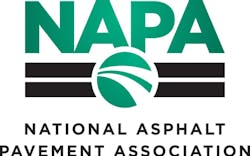NAPA responds to climate change research on asphalt pavement design
The National Asphalt Pavement Association (NAPA) recently released a statement in response to a study published by the journal Nature Climate Change which suggested modern asphalt roads were not equipped to withstand climate change.
Roads & Bridges reported on the study last month. The statement from NAPA indicates the association believes road owners and road builders have taken the necessary steps to address the concerns raised by the study.
NAPA's statement can be found below.
-------------
Asphalt pavements aren't melting
Several news outlets have recently reported on a published letter (Underwood et al., 2017) asserting that, unless pavement design methodologies take into account changing climate data, pavements built today may not hold up under future weather conditions. While we disagree with the conclusion, the basic premise underlying the paper’s thesis—that pavement design must be based on inputs that are calibrated to local conditions and real-world performance data—is one NAPA supports.
In the specific case of the sort of temperature data Underwood et al. (2017) considers, FHWA has taken a close look at this issue (Schwartz et al., 2015) and now draws upon NASA’s Modern-Era Retrospective Analysis for Research and Applications (MERRA) climate data sets for InfoPave and the LTPPBind Online asphalt binder performance grade section tool (FHWA, 2017a; 2017b). Under the AASHTO M 323-17 specifications, LTPPBind is the tool to be used in determining the proper PG grade binder for a project (AASHTO, 2017), and FHWA has developed the LTPPBind Online tool to ensure that the most up-to-date data is available.
MERRA combines data from ground-, ocean-, atmospheric-, and space-based observations and reanalyzes it into a consistent data set tracking temperature and other climate changes on an hourly basis (Rienecker et al., 2011). MERRA data sets run through early 2016 at which time the MERRA-2 project began; InfoPave, including LTPPBind, was updated to support MERRA-2 data sets in July 2017 (InfoPave, 2017).
The incorporation of MERRA/MERRA-2 data set within LTPPBind negates the scenario hypothesized by Underwood et al. (2017). Today’s engineering practices account for changing climate data in their pavement designs, just as they account for changing traffic levels. Even though the incorporation of MERRA data into LTPPBind is a new development, road owners and road builders have regularly adapted designs and materials to meet changing needs and to take advantage of innovations in technologies and construction practices. And, because of how asphalt pavement structures are designed to carry loads, it is possible to modify or upgrade the surface layer of the pavement to meet changing needs as part of routine maintenance or resurfacing without having to reconstruct the entire pavement structure.
The central point of Underwood et al. (2017) is that road building and materials are not changing and adapting to meet future needs; this does not match with current or past practices. The adaptability and flexibility of asphalt pavements, and our ability to apply innovation, are part of how our industry ensures resilient infrastructure that meets our changing needs.
References
AASHTO (2017). Standard Specification for Superpave Volumetric Mix Design (AASHTO Designation M 323-17). Washington, D.C.: American Association of State and Highway Transportation Officials.
FHWA (2017a). Product Brief: Long-Term Pavement Performance Bind Online (Publication No. FHWA-HRT-17-009). McLean, Virginia: Office of Infrastructure Research and Development, Federal Highway Administration.
FHWA (2017b). LTPP InfoPave: Release 2017 — What’s New (Publication No. FHWA-HRT- 17-030). Washington, D.C.: Federal Highway Administration.
InfoPave (2017, July 5). Release Notes: LTPP InfoPave 2017 w/SDR 31 and MERRA 2. https://infopave.fhwa.dot.gov/Page/Type/ReleaseNotes
Rienecker, M.M., M.J. Suarez, R. Gelaro, R. Todling, J. Bacmeister, E. Liu, M.G. Bosilovich, S.D. Schubert, L. Takacs, G.-K. Kim, S. Bloom, J. Chen, D. Collins, A. Conaty, A. da Silva, W. Gu, J. Joiner, R.D. Koster, R. Lucchesi, A. Molod, T. Owens, S. Pawson, P. Pegion, C.R. Redder, R. Reichle, F.R. Robertson, A.G. Ruddick, M. Stienkiewicz, & J. Woollen (2011). MERRA: NASA’s Modern-Era Retrospective Analysis for Research and Applications. Journal of Climate, Vol. 24, No. 14, pp. 3624–3648. doi:10.1175/JCLI-D-11-00015.1
Schwartz, C.W., G.E. Elkins, R. Li, B.A. Visintine, B. Forman, G.R. Rada, & J.L. Groeger (2015). Evaluation of Long-Term Pavement Performance (LTPP) Climatic Data for Use in Mechanistic-Empirical Pavement Design Guide (MEPDG) Calibration and Other Pavement Analysis (Report No. FHWA-HRT-15-019). McLean, Virginia: Office of Infrastructure Research and Development, Federal Highway Administration.
Underwood, B.S., Z. Guido, P. Gudipudi, & Y. Feinberg (2017). Increased costs to U.S. pavement infrastructure from future temperature rise. Nature Climate Change Vol. 7, No. 10, pp. 704–707. doi:10.1038/nclimate3390
------------
Source: NAPA
